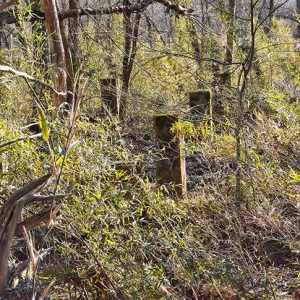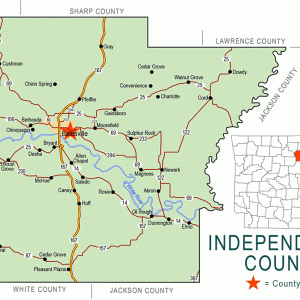calsfoundation@cals.org
Curia (Independence County)
The historic community of Curia (pronounced Curie) was located near Curia Creek, a tributary of the Black River, east of Highway 25 between Saffell (Lawrence County) and Cord (Independence County). The remains of this community, like Hazel Grove (Independence County), are on private land with restricted public access. It was located in Barren Township. Curia Lake is a popular fishing spot noted for its perch and crappie.
The place name of Curia (a.k.a. Bayou Cura, Bayou Cure, and Cura Creek) is mentioned in a written description of the boundaries of the new Independence County on October 23, 1820, which included, “All that portion of the county of Lawrence bounded as follows, to wit: Beginning at a point in Big Black River halfway between the mouth of Strawberry and Bayou Cure.” However, no map has been found that shows original boundary lines. In 1834, geologist George William Featherstonhaugh made his famous trek down the Jackson Military Road that paralleled the Southwest Trail and wrote about Curia Creek. Featherstonhaugh found the road “a great comfort to travelers in such a wilderness.”
One of the first settlers of Curia was Benjamin Franklin Ball from Loudoun County, Virginia, who was farming on Curia Creek by the time of his first marriage in 1832 to Elizabeth Ann (Betsey) Dillard, having arrived in the Arkansas Territory in 1826. The Ball Trading Post was the first trading post in the Curia area. The Balls had fourteen children. Following the death of Betsey Ball, Ball had four more children with his second wife, Minerva Naomi Musgrove Ball, widow of Harrison Baker. Baker had been a prominent landowner of Curia.
Benjamin Ball was selected as a member of the Arkansas Home Guard of Minute Men in 1861 to support the Confederacy and to provide for local defense until regular military regiments could be raised and deployed. Most of those chosen were property owners—many of whom were prominent and wealthy by the standards of the day.
When Benjamin Ball died in 1889 at the age of eighty-two, he was buried in the Ball Cemetery on his farm in Curia, alongside his two wives. At the time of his death, Ball owned 205 acres in the Curia area. He was an active member of the Methodist Church and a Mason. He supported his son Corporal Clinton Monroe Ball’s leadership in the Agricultural Wheel in Independence County. Clinton Ball had served for the Confederacy during the Civil War in Company G, Twenty-seventh Arkansas Infantry, and he was a corporal in the Fourth Arkansas Mounted Infantry.
The community of Curia had a post office as part of a general store from 1848 until 1913. Harrison Baker was appointed the first postmaster on December 7, 1848. Zachariah W. Vincil, an early settler of Curia from Virginia, was appointed postmaster in 1851. By 1860, according to land records, Vincil had amassed over 400 acres of land in the area, including 120 acres in Lawrence County. In the midst of the Civil War, his first wife, Elmira White from North Carolina, died. He then married Mary McLeod of Curia, whose family came from Scotland.
A steam-driven sawmill was located on Curia Creek near Curia. A sorghum mill on Lake Curia was noted for its fine sorghum molasses. During the Civil War, both the Union and Confederate armies came to Curia to mine lead to make bullets. It is said that the community had a large supply of high-quality lead.
Curia was on a main military road used during the Civil War and was caught in the middle, since the area had many pro-Union supporters. In his report on an expedition from Batesville (Independence County) on February 21, 1864, Lieutenant Colonel William Baumer of the First Nebraska Cavalry wrote: “Met two flags of truce from Freeman’s command, bringing in Captain Rouch and 18 privates of the Eleventh Missouri Cavalry, for exchange. At cross-roads deployed skirmishers in the hills, and halted for ten minutes to rest the animals; distance to this point, 12 miles. At 1.30 p.m. passed Curia Post-Office, taking Hookram road; distance, 15 miles. At 2 p.m. crossed road coming in from northeast; at 3 p.m. halted and fed at McCord’s on the Hookram road, 20 miles from Batesville.”
The Curia school, grades 1–8, was established in the late 1800s and merged with the Charlotte School District in 1940. Beginning in 1926, Highway 25 bypassed Curia and Hazel Grove, becoming the main road between Cord and Strawberry (Lawrence County). In 1946, the bridge at Curia Creek washed away and was not replaced, further isolating the community and causing the last of the residents to move away. The remains of Curia have returned to the wilderness and are difficult to discern.
Curia Creek flows from Cave City (Sharp and Independence counties) past the historic community of Curia. Its banks are nesting places for blue heron. A few of the well-known deep spots in the creek are Log Hole, Bluff Hole, Graveyard Hole, and Carter Hole. Fishing and swimming are popular, and baptisms often take place in the creek. Pollution from upstream threatened the fish population in Curia Creek in the late twentieth century, especially the rock bass, flathead cat, and small-mouth bass. The Environmental Protection Agency helped clean up the creek, a project finished by 2002.
For additional information:
Biographical and Historical Memoirs of Northeast Arkansas. Chicago: Goodspeed Publishing Company, 1889.
Featherstonhaugh, George W. Excursion through the Slave States, from Washington on the Potomac to the Frontier of Mexico; with Sketches of Popular Manners and Geological Notices. New York: Negro Universities Press, 1968.
McGinnis, A. C. “A History of Independence County, Ark.” Special issue. Independence County Chronicle 17 (April 1976).
Powell, Wilson. “Harold White’s Story.” Batesville Guard, February 4, 2002, p. 2.
Kenneth Rorie
Van Buren, Arkansas
 Curia Creek Bridge
Curia Creek Bridge  Independence County Map
Independence County Map 



Comments
No comments on this entry yet.